If you’re battling carpal tunnel or wrist pain, I recommend ergonomic mice with a vertical, handshake design that promote natural wrist alignment. Models like the Logitech Lift, TECKNET vertical mice, and LEKVEY support long hours and feature adjustable DPI, quiet buttons, and multi-device connectivity. They’re lightweight and suited for small to medium hands, helping reduce tension and discomfort. Want to find out which options best fit your needs? Keep going to explore more helpful choices.
Key Takeaways
- Vertical, handshake-style mice promote natural wrist alignment, reducing strain associated with carpal tunnel syndrome.
- Adjustable DPI and customizable buttons enable precise control, minimizing repetitive movements that aggravate symptoms.
- Wireless connectivity with multi-device support offers flexible, clutter-free setup for comfortable extended use.
- Ergonomic designs with compact, lightweight builds support relaxed hand posture for small to medium hands.
- Features like silent clicking and long battery life enhance user comfort and reduce fatigue during prolonged use.
TECKNET 2.4G Ergonomic Wireless Mouse
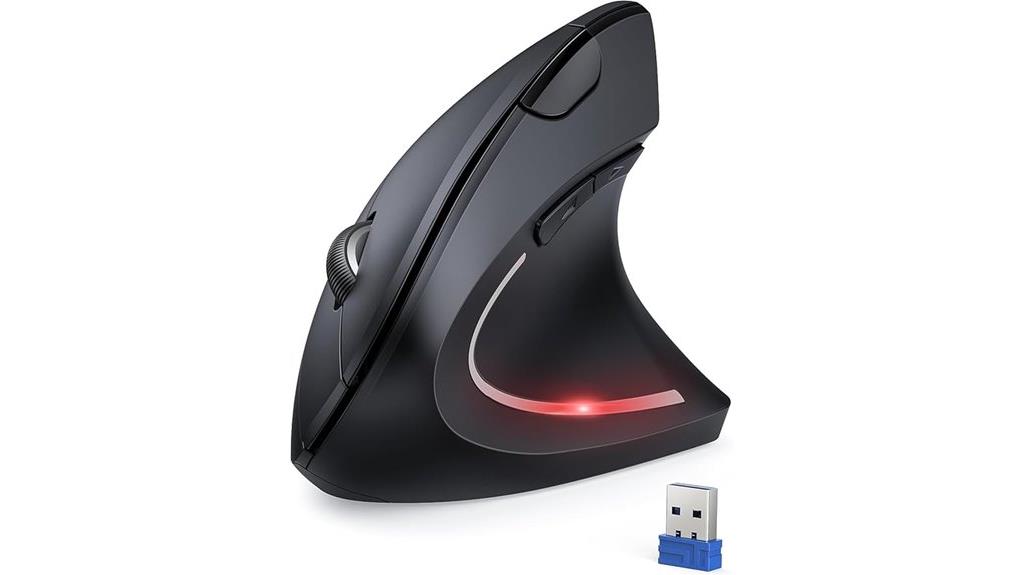
If you’re looking for an ergonomic mouse that provides real relief from wrist pain during long hours at the computer, the TECKNET 2.4G Ergonomic Wireless Mouse is an excellent choice. Its vertical design promotes a neutral hand position, reducing stress on your wrist and arm, while lowering the risk of tendinitis or carpal tunnel syndrome. The mouse features a high-precision 4800 DPI optical sensor, adjustable in five levels, for smooth, accurate tracking. With six buttons—including side navigation—it’s great for productivity. Easy to set up with a USB receiver, it offers quiet clicks and reliable wireless performance up to 49 feet, making it ideal for extended use.
Best For: users experiencing wrist or arm discomfort during extended computer use who want an ergonomic, comfortable mouse to help reduce pain and improve posture.
Pros:
- Promotes natural hand position to reduce wrist stress and prevent repetitive strain injuries
- Adjustable 4800 DPI sensor offers precise, smooth tracking suitable for various tasks
- Quiet clicking and reliable wireless connection enhance user comfort and minimize disturbances
Cons:
- Larger size may be awkward or less portable for some users
- Designed specifically for right-handed users, limiting versatility
- Some users report battery life inconsistency depending on usage patterns
Logitech Lift Vertical Ergonomic Wireless Mouse
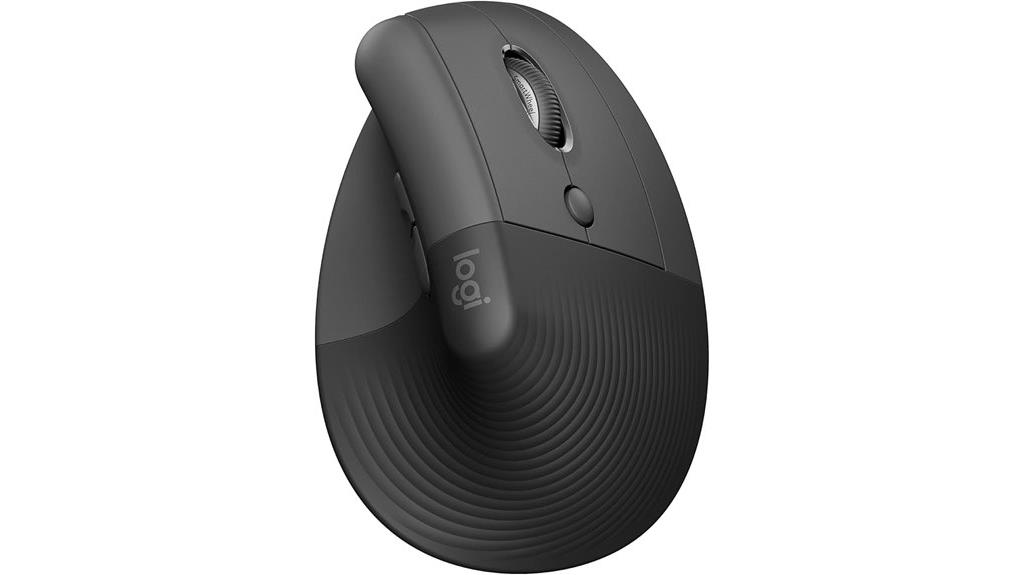
The Logitech Lift Vertical Ergonomic Wireless Mouse is an excellent choice for those seeking long-lasting wrist relief, thanks to its 57-degree elevated design that promotes a natural forearm posture. Its thoughtfully crafted shape fits small to medium hands, offering a textured grip and a snug thumb rest for added comfort. With multi-OS support and easy device switching, it’s versatile for work across platforms. The mouse’s impressive 24-month battery life, precise 4000 DPI tracking, and quiet, responsive buttons enhance daily productivity. Many users report reduced wrist pain and improved posture, making it an ideal ergonomic option for anyone seeking sustainable relief from carpal tunnel strain.
Best For: users seeking long-lasting ergonomic wrist support and comfort for extended use across multiple operating systems.
Pros:
- Promotes natural wrist and forearm posture with a 57-degree ergonomic angle
- Outstanding 24-month battery life reduces the need for frequent charging or replacements
- Compatible with multiple OS platforms and supports easy device switching with Logitech Flow
Cons:
- Slightly larger dimensions may not be suitable for very small hands or tight workspace setups
- Requires Bluetooth or Logi Bolt USB receiver, which may need additional setup for some users
- Premium features like customization require Logi Options+ software, which may not be compatible with all devices
Ergonomic Wireless Rechargeable Mouse (3-in-1: Bluetooth, USB A, Type C)
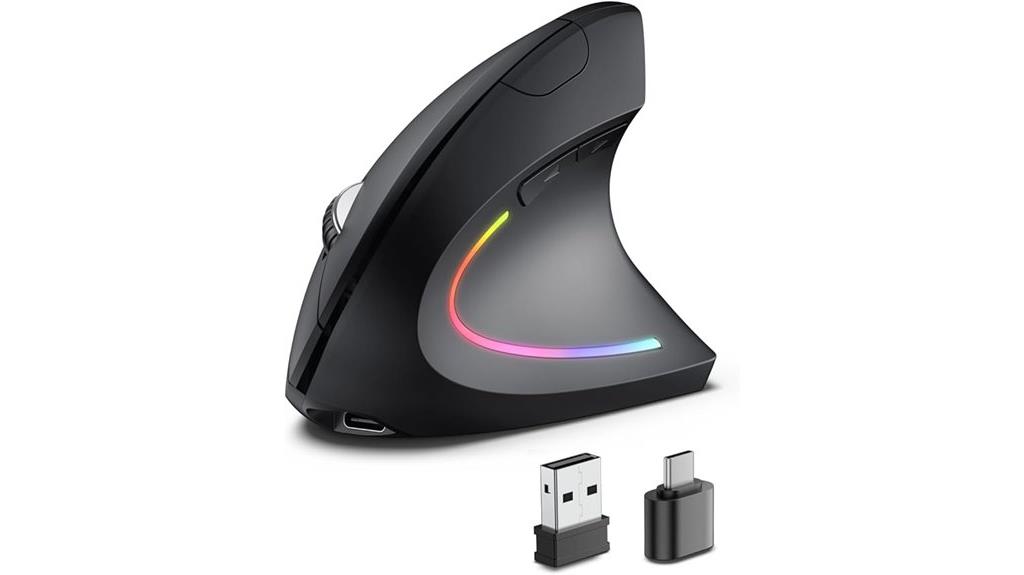
Designed for users seeking seamless device switching and versatile connectivity, the Ergonomic Wireless Rechargeable Mouse (3-in-1: Bluetooth, USB A, Type C) supports three connection methods that let me switch effortlessly between my laptop, tablet, and desktop without hassle. Its vertical ergonomic design with a 58-degree angle fits my palm naturally, reducing wrist strain and promoting a healthy posture. The mouse’s silent buttons and precise optical tracking make it comfortable and accurate for long hours. With a rechargeable battery lasting up to three months, I enjoy hassle-free use. Its durable build and compatibility across various devices make it a versatile choice for alleviating carpal tunnel symptoms.
Best For: users seeking an ergonomic, versatile wireless mouse that easily switches between multiple devices and provides comfortable, long-term use.
Pros:
- Supports three connection methods (Bluetooth 5.3, USB A, Type C) for seamless device switching
- Ergonomic vertical design reduces wrist and arm stress, promoting healthy posture
- Long-lasting rechargeable battery (up to three months) with quiet, responsive buttons
Cons:
- Shallow vertical angle may not suit all users’ ergonomic preferences
- Back and forward shortcut keys are not functional on macOS systems
- Slightly shallow grip for users with larger hands or specific palm shapes
TECKNET Wireless Ergonomic Vertical Mouse with Adjustable DPI
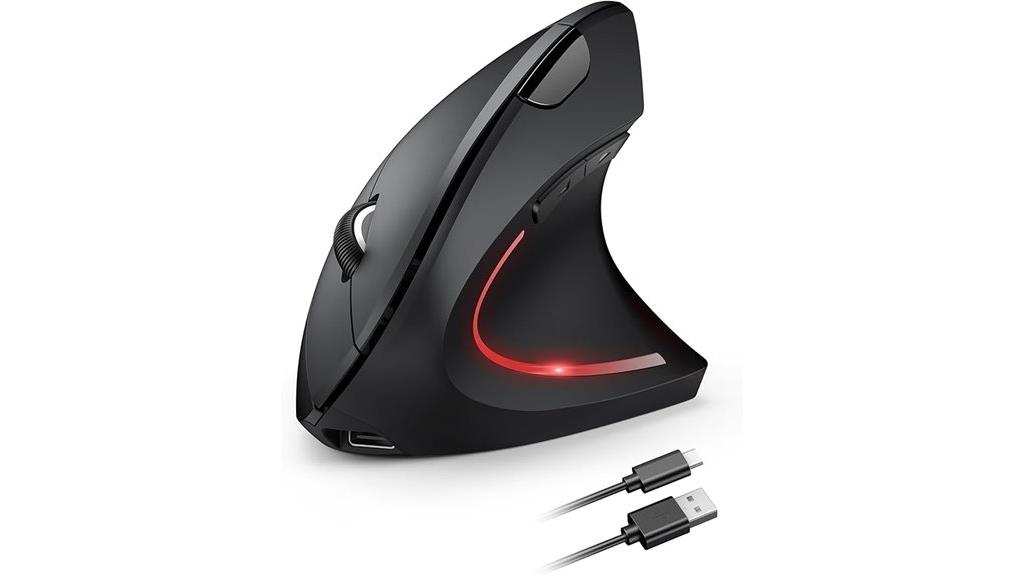
For anyone seeking a comfortable, low-noise mouse for long hours at their desk, the TECKNET Wireless Ergonomic Vertical Mouse with Adjustable DPI stands out as an excellent choice. Its vertical design promotes a natural wrist and arm position, reducing fatigue and strain during extended use. The silent-click technology guarantees quiet operation, perfect for shared spaces or quiet environments. With a reliable 2.4 GHz wireless connection and a 10-meter range, you won’t experience interruptions. The adjustable DPI levels from 4800 to 800 allow for tailored sensitivity, whether you’re working or designing. Plus, its quick-charging battery lasts around two months, making it a practical, ergonomic solution.
Best For: users seeking a comfortable, quiet, and precise ergonomic mouse for long hours of work or design tasks.
Pros:
- Ergonomic vertical design reduces wrist and arm fatigue during extended use.
- Silent-click technology ensures quiet operation in shared or quiet environments.
- Adjustable DPI levels offer customizable sensitivity for various tasks.
Cons:
- Does not support Bluetooth or USB-C connections, relying solely on USB-A receiver.
- Auxiliary keys are not silent, which may produce noise during use.
- Cannot be used on glass surfaces due to optical tracking limitations.
LEKVEY Vertical Wireless Ergonomic Mouse (3 Adjustable DPI, Black)
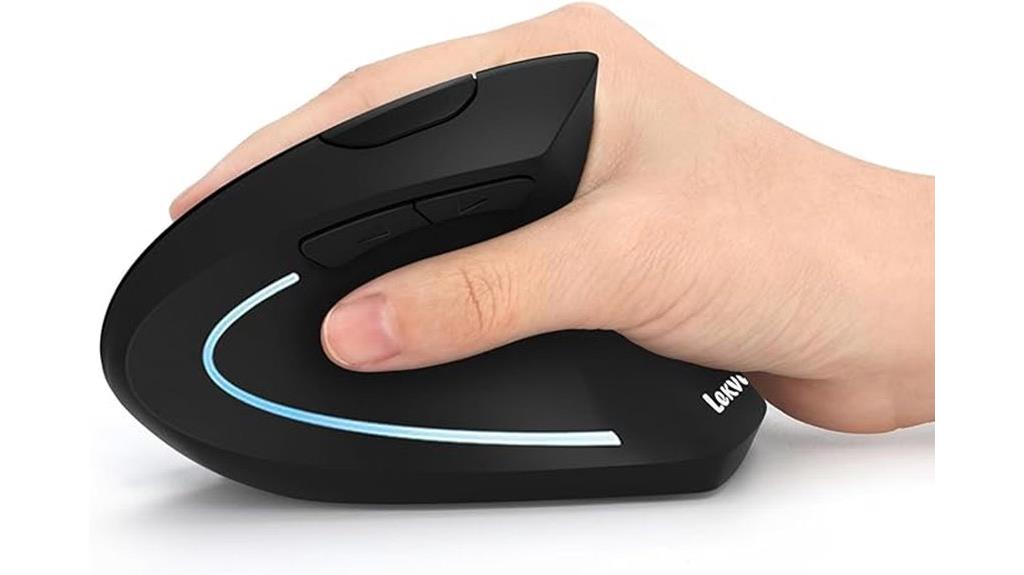
If you’re seeking an ergonomic mouse that reduces wrist strain without sacrificing responsiveness, the LEKVEY Vertical Wireless Ergonomic Mouse stands out. Its sleek, vertical design promotes a natural, neutral wrist position, which many users say eases pain within days. Designed for medium to large hands, it offers a comfortable grip with textured surfaces, and features three adjustable DPI settings (800/1200/1600) for tailored sensitivity. The mouse operates quietly, with smooth scrolling and easy button access, including page back/forward. Wireless and rechargeable, it lasts around 150 hours per charge, making it reliable for long work sessions. Overall, it’s a practical, health-conscious choice for reducing carpal tunnel discomfort.
Best For: users seeking an ergonomic, health-conscious mouse that reduces wrist strain during long hours of work, programming, or browsing.
Pros:
- Promotes a natural wrist position, significantly reducing discomfort and pain.
- Long-lasting battery life of around 150 hours per charge, with quick recharge capability.
- Comfortable for medium to large hands with textured grip and quiet operation.
Cons:
- Some users report occasional cursor jumping and scroll wheel glitches over extended use.
- The vertical design may feel unconventional or take some adjustment for new users.
- Slightly larger dimensions might not suit users with smaller hands or limited desk space.
Anker Wireless Vertical Ergonomic Optical Mouse

The Anker Wireless Vertical Ergonomic Optical Mouse stands out as a top choice for users experiencing wrist pain, tendinitis, or carpal tunnel syndrome, thanks to its scientifically engineered vertical design. Its natural handshake posture helps promote healthy wrist and arm alignment, reducing strain during long hours at the computer. While larger hands find it particularly comfortable, smaller hands may need some adjustment. The smooth surface can cause slippage, so using wrist supports is recommended for extended use. Equipped with precise optical tracking and five functional buttons, it’s suitable for browsing, work, or gaming, making it a versatile and affordable ergonomic option.
Best For: users experiencing wrist pain, tendinitis, or carpal tunnel syndrome seeking an ergonomic and affordable mouse solution.
Pros:
- Promotes healthy wrist and arm positioning with its vertical, handshake design
- Precise optical tracking with adjustable DPI for smooth movement across surfaces
- Quiet operation and plug-and-play setup make it suitable for shared or quiet environments
Cons:
- Surface slipperiness may require wrist supports for extended use
- Smaller hands may find button reach challenging, necessitating an adjustment period
- Limited customization options without dedicated software, and some users report connection issues or lack of indicator lights

Designed with comfort in mind, the Lekvey Ergonomic Wireless Vertical Mouse is ideal for those seeking to reduce wrist strain during long hours at the computer. Its vertical design promotes a natural, neutral wrist position, helping to prevent strain and discomfort. Featuring six buttons, including advanced page navigation, and adjustable DPI settings (800/1200/1600), it offers precise control for various tasks. The sleek, trendy colors add style, while quiet-click buttons minimize noise. With a rechargeable battery lasting up to 150 hours and simple plug-and-play connectivity via a USB receiver, it’s a versatile choice for home, office, or travel, supporting ergonomic health during extended use.
Best For: users seeking an ergonomic, stylish wireless mouse with customizable controls for long hours of computer use in home, office, or travel settings.
Pros:
- Promotes healthy wrist positioning with its vertical ergonomic design
- Adjustable DPI levels (800/1200/1600) for precise sensitivity control
- Rechargeable battery provides long-lasting use up to 150 hours on a single charge
Cons:
- Not ideal for users with small hands due to its size
- Requires a USB-A port for the nano receiver; MacBook users may need an adapter
- Limited to Windows, Linux, and Mac OS X compatibility; no Bluetooth support
TECKNET Ergonomic Wireless Mouse with 6 Buttons and Adjustable DPI
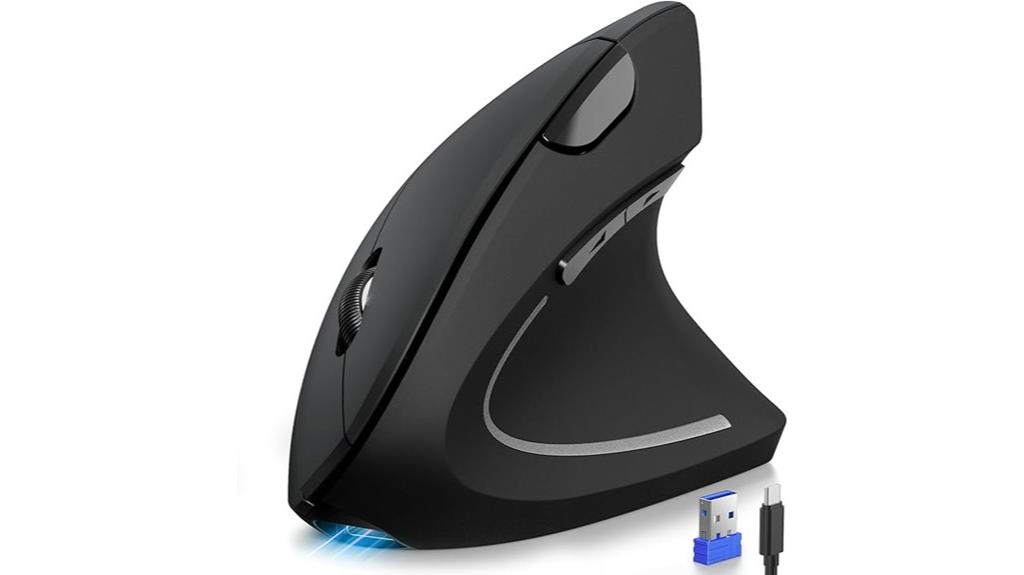
For those seeking an ergonomic mouse that combines versatility with comfort, the TECKNET Wireless Mouse stands out. It offers three connection modes—Bluetooth 5.0, Bluetooth 3.0, and a 2.4GHz USB receiver—making multitasking across devices easy. Designed for medium to large right-handed users, it features a vertical, ergonomic shape that promotes natural wrist alignment, reducing strain. With six buttons, including forward/back controls, and adjustable DPI up to 4800, it provides precise navigation on various surfaces. Its soft-touch, lightweight design, combined with silent clicks and textured scroll wheel, makes long hours comfortable. Plus, it supports multi-device switching and has a long-lasting rechargeable battery.
Best For: users with medium to large right-handed hands seeking a versatile, ergonomic wireless mouse for multitasking across multiple devices.
Pros:
- Ergonomic vertical design reduces wrist strain and promotes natural arm positioning
- Supports three connection modes (Bluetooth 5.0, Bluetooth 3.0, 2.4GHz USB) for easy device switching
- Adjustable DPI up to 4800 for precise control across various surfaces
Cons:
- Some users report battery life issues or early device failures after a few months
- Not compatible with Mac side buttons or certain Mac OS functions
- May be less durable over long-term heavy use according to some reviews
Anker Ergonomic USB Wired Vertical Mouse with 1000/1600 DPI
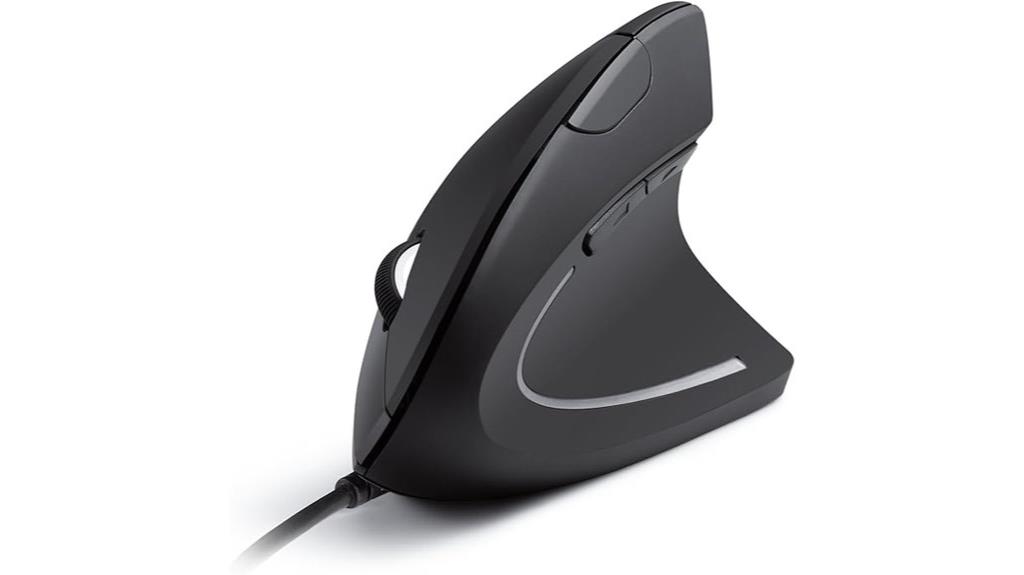
If you’re seeking an affordable, highly effective solution for reducing wrist strain, the Anker Ergonomic USB Wired Vertical Mouse with 1000/1600 DPI stands out as an excellent choice. Its scientifically engineered design promotes a neutral handshake wrist and arm position, which helps minimize discomfort during long hours at your desk. With adjustable DPI settings, five buttons—including forward/backward navigation—and a silent textured scroll wheel, it offers both comfort and functionality. Compact and lightweight, it’s compatible with Windows and Linux, powered via USB without batteries. Users report significant relief from wrist pain and improved posture, making it a practical, budget-friendly option for everyday use.
Best For: users seeking an affordable, ergonomic vertical mouse that alleviates wrist strain during extended computer use.
Pros:
- Promotes healthy wrist and arm posture, reducing discomfort and risk of carpal tunnel syndrome
- Adjustable DPI (1000/1600) for customizable sensitivity and smooth operation
- Compact, lightweight design with durable build and silent scroll wheel for comfortable daily use
Cons:
- Not ideal for professional-level precision tasks or gaming requiring pixel-perfect accuracy
- Initial adjustment period needed to become accustomed to the vertical orientation
- Limited customization options, such as adjustable weights or width adjustments
TECKNET Wireless Ergonomic Vertical Mouse with Adjustable DPI
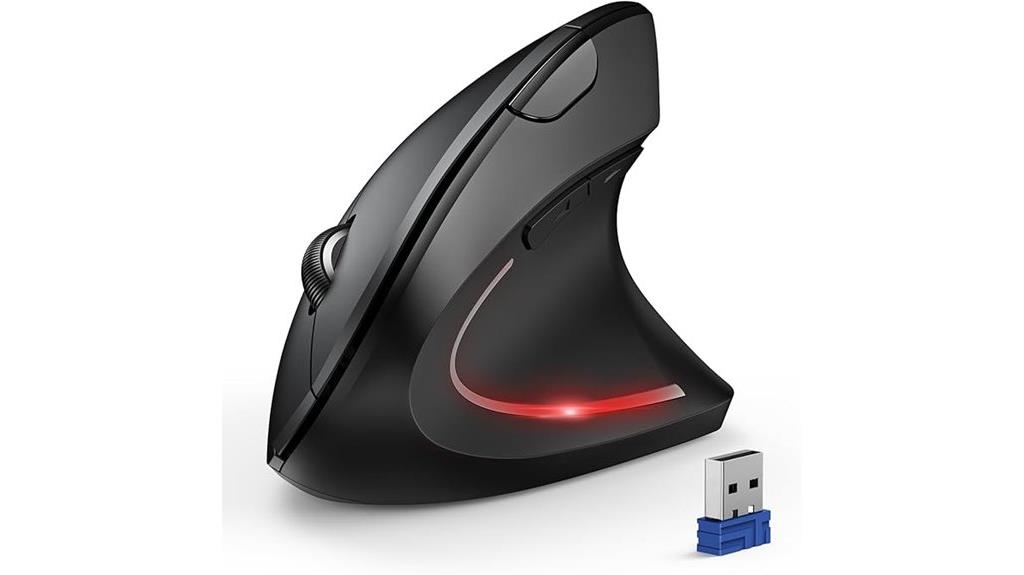
The TECKNET Wireless Ergonomic Vertical Mouse with Adjustable DPI stands out as an excellent choice for anyone seeking a comfortable, customizable mouse that reduces wrist strain during long work sessions. Its seamless switching among three devices via Bluetooth and 2.4GHz USB ensures flexibility, with Bluetooth supporting two devices simultaneously. The adjustable DPI settings (800–4800) allow precise control on various surfaces, and the near-vertical design promotes a natural, palm-up position that minimizes strain. Quiet clicks and deep sleep mode make it suitable for quiet environments and energy efficiency. With a 12-month battery life and a 36-month warranty, it offers durability and peace of mind for daily use.
Best For: those seeking a comfortable, ergonomic, and customizable mouse that minimizes wrist strain during long hours of work or study.
Pros:
- Adjustable DPI levels (800–4800) for precise control across different surfaces
- Seamless switching among three devices via Bluetooth and 2.4GHz USB modes
- Near-vertical ergonomic design reduces wrist pressure and enhances comfort
Cons:
- Requires 2 AAA batteries (not included), which may need frequent replacement
- Side buttons are not compatible with Mac systems
- Only primary buttons operate silently; other function buttons produce noise
SUNGI Ergonomic Wireless Vertical Mouse with Adjustable DPI
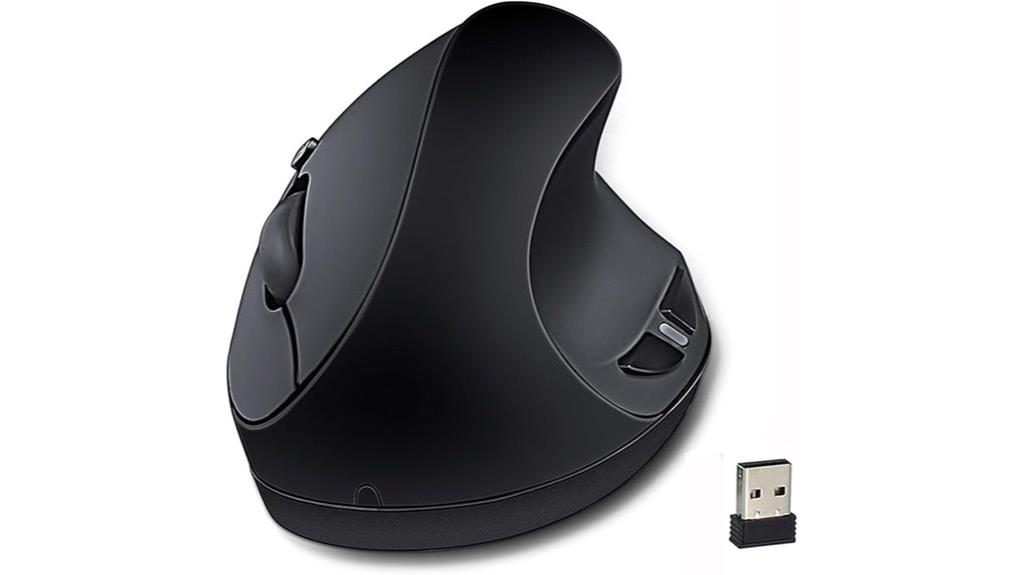
The SUNGI Ergonomic Wireless Vertical Mouse with Adjustable DPI stands out as an excellent choice for anyone seeking natural wrist alignment and relief from carpal tunnel symptoms. Its vertical design promotes a comfortable “handshake” position, reducing wrist strain, especially for small to medium hands. With rubber oil surface coating, it feels smooth and comfortable during extended use. The mouse offers adjustable DPI settings—800, 1200, and 1600—allowing personalized cursor control. Wireless connectivity via a 2.4GHz USB receiver provides up to 10 meters of freedom. Overall, it’s a practical, affordable option that helps alleviate wrist discomfort for RSI sufferers and long-term users alike.
Best For: users seeking an ergonomic, comfortable mouse that reduces wrist strain and is suitable for small to medium hands, especially RSI sufferers and long-term users.
Pros:
- Promotes natural “handshake” wrist position to reduce strain
- Adjustable DPI settings (800/1200/1600) for personalized cursor control
- Wireless connectivity with a long 10-meter range and easy plug-and-play setup
Cons:
- Some users report issues with sliders and dragging on certain surfaces
- Not compatible with Mac OS; limited to Windows, Android, and Linux
- May have durability concerns or mouse stopping unexpectedly after prolonged use
Bluetooth and 2.4G Rechargeable Wireless Mouse with Vertical Design
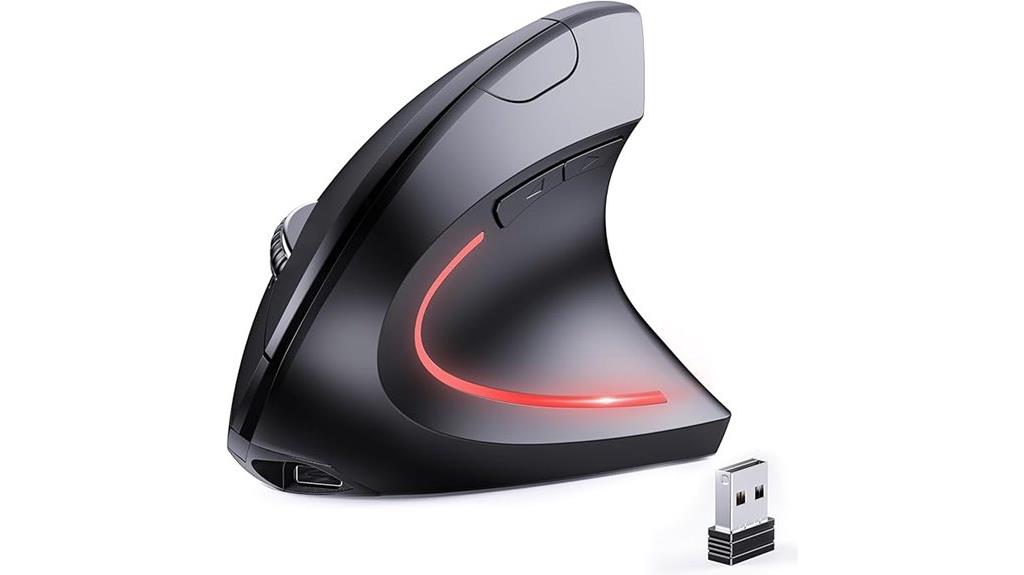
A Bluetooth and 2.4G rechargeable wireless mouse with a vertical design offers an excellent solution for anyone seeking to reduce wrist strain during long hours at the computer. Its dual connectivity allows seamless switching between Bluetooth (5.2/3.0) and 2.4GHz USB, supporting a wide range of devices like Windows, Mac, Linux, Android, and smartphones. The ergonomic vertical shape promotes a natural handshake, minimizing wrist and arm fatigue. Plus, it connects to two devices simultaneously—one via Bluetooth and one via USB—making multitasking easier. With silent buttons, precise DPI options, and a rechargeable battery lasting up to three months, it’s a versatile choice for comfortable, extended use.
Best For: users seeking an ergonomic, versatile wireless mouse that reduces wrist strain and supports multitasking across multiple devices.
Pros:
- Dual connectivity with Bluetooth 5.2/3.0 and 2.4GHz USB for flexible device pairing.
- Ergonomic vertical design promotes natural hand posture, decreasing fatigue.
- Long-lasting rechargeable battery (up to three months) with easy Type-C charging.
Cons:
- Not fully compatible with Mac OS for web navigation buttons.
- Requires careful handling of the charging port to avoid damage.
- May not suit users preferring traditional horizontal mouse designs.
TECKNET Wireless Vertical Mouse with 4800 DPI and Adjustable Levels
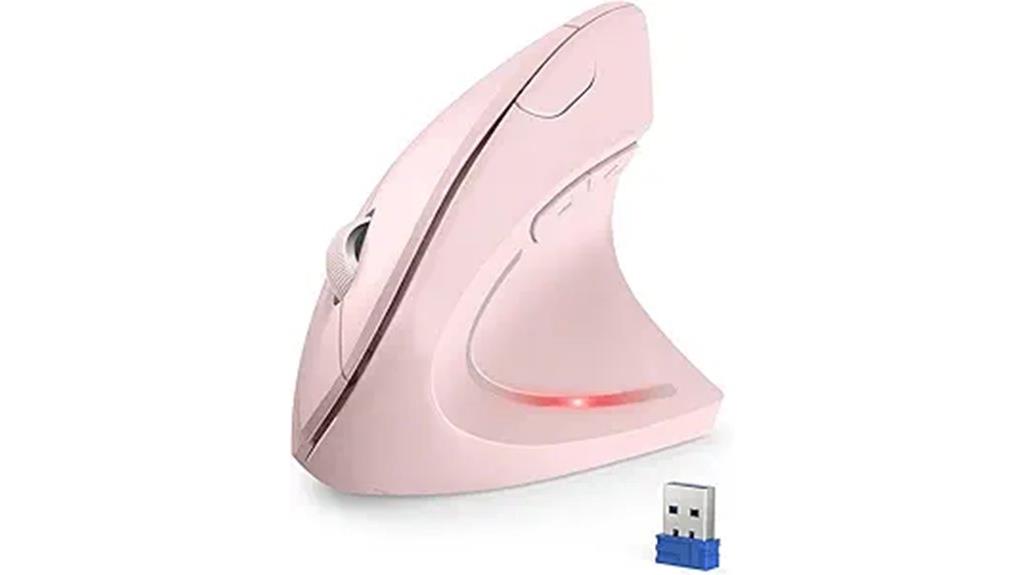
If you’re seeking an ergonomic mouse that offers precise control and customizable settings, the TECKNET Wireless Vertical Mouse with 4800 DPI and adjustable levels is an excellent choice. Its vertical design promotes proper arm and wrist alignment, helping reduce muscle tension during long hours. With adjustable DPI options up to 4800, you can tailor cursor speed to your needs, whether for detailed work or quick navigation. It’s compatible with Windows, Mac, and Linux, and features silent clicking for quiet operation. The 15-meter wireless range and energy-saving sleep mode make it practical for daily use. Overall, it’s a versatile, comfortable option for anyone seeking ergonomic relief.
Best For: users seeking an ergonomic, customizable wireless mouse suitable for long hours of work or gaming across multiple operating systems.
Pros:
- Promotes ergonomic arm and wrist alignment to reduce muscle tension
- Adjustable DPI up to 4800 for precise, smooth control on various surfaces
- Quiet clicking minimizes noise, ideal for shared or quiet environments
Cons:
- Requires 2 AAA batteries (not included) and may need branded batteries for optimal performance
- Side buttons are not compatible with Mac/iOS systems
- May need an adapter for devices without USB-A ports to connect the wireless receiver
ProtoArc Ergonomic Mouse EM11 NL Bluetooth Wireless Vertical Mouse

Designed specifically for small to medium hands, the ProtoArc EM11 NL Bluetooth Wireless Vertical Mouse offers an ergonomic vertical shape that promotes a natural wrist and forearm position. This design helps reduce discomfort, strain, and the risk of repetitive strain injuries, making it a great choice for those seeking relief. The soft-touch outer skin provides a comfortable grip, encouraging a relaxed hold that minimizes fatigue during long use. With adjustable DPI levels (1000/1600/2400), it delivers precise tracking for efficient work. While there’s a brief learning curve, users often find that wrist comfort improves considerably over time, making this mouse a solid ergonomic upgrade.
Best For: users with small to medium hands seeking an ergonomic, wireless vertical mouse to reduce wrist strain and improve comfort during extended computer use.
Pros:
- Promotes natural wrist and forearm positioning, reducing discomfort and strain
- Supports multi-device connectivity via Bluetooth and USB, allowing seamless switching between devices
- Quiet click buttons enhance focused work without disturbing surroundings
Cons:
- The vertical design may require a 1-2 week adjustment period for new users
- All buttons are not programmable; forward/back buttons are incompatible with Mac OS
- Limited DPI options (1000/1600/2400), which may not satisfy users needing higher sensitivity
Hokafenle 2-in-1 Ergonomic Mouse Pad with Wrist Support and Rest

The Hokafenle 2-in-1 Ergonomic Mouse Pad with Wrist Support and Rest is an excellent choice for anyone seeking to alleviate wrist strain during long hours at the computer. Its full memory gel and massage beads provide targeted support, reducing carpal tunnel pain and fatigue. The silky lycra surface ensures smooth mouse movement, compatible with various mouse types. The wrist rest’s 0.8-inch height improves typing angles and relieves joint pressure. Its non-slip PU base stays securely in place, while the inclined slope and massage bumps promote airflow and comfort. Overall, this set offers durable, ergonomic support, making it a practical addition to any workspace.
Best For: those experiencing wrist strain or carpal tunnel syndrome who need ergonomic support during extended computer use.
Pros:
- Provides targeted wrist support with full memory gel and massage beads for relief and comfort
- Made with smooth lycra fabric that allows precise mouse movements and is compatible with various mouse types
- Features a non-slip PU base that keeps the set securely in place during use
Cons:
- Some users report issues with color accuracy and fading over time
- Cleaning can be challenging, with some difficulty maintaining appearance after extended use
- Slightly larger dimensions may take up more desk space than smaller alternatives
Factors to Consider When Choosing Ergonomic Mice for Carpal Tunnel
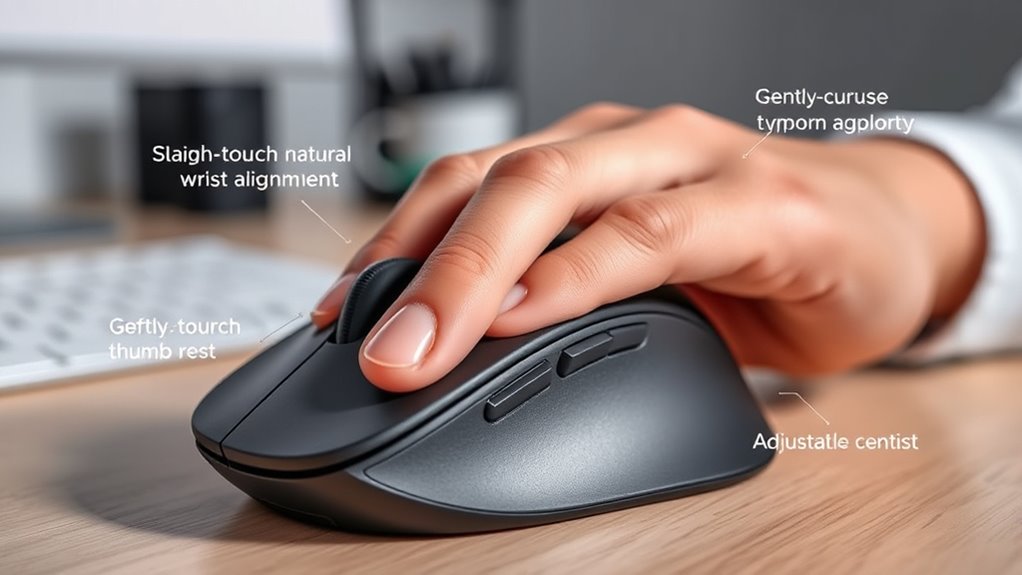
When choosing an ergonomic mouse for carpal tunnel relief, I focus on design features that promote natural hand positioning and comfort. It’s also important to take into account whether the mouse fits my hand size and offers adjustable settings like DPI for precision. Finally, I look at connection options and button customization to guarantee the mouse meets my specific needs.
Ergonomic Design Features
Choosing an ergonomic mouse involves considering features that support a natural and comfortable hand position. A vertical or angled design encourages a handshake posture, reducing wrist torsion and muscle strain. Adjustable DPI settings are essential, allowing you to customize sensitivity for precise control and minimize repetitive movements. Quiet or silent-click buttons help reduce noise and vibrations, making extended use more comfortable. Proper size and shape are critical; the mouse should fit your hand comfortably, promoting a relaxed grip and preventing unnecessary tension. Additional features like textured surfaces, thumb rests, and adjustable arm supports further enhance wrist positioning and overall ergonomic health. These design elements work together to promote comfort, reduce strain, and support long-term hand wellness.
Hand Size Compatibility
Selecting an ergonomic mouse that fits your hand comfortably is essential for reducing strain and preventing aggravation of carpal tunnel symptoms. To do this, start by measuring your hand size and choosing a mouse designed for small, medium, or large hands. Larger mice offer better palm support for bigger hands, while smaller mice suit those with compact hands better. Pay attention to the width and length of the mouse, making sure they match the natural span of your fingers and palm. The shape and contour should align with your hand’s natural posture, helping to minimize wrist twisting and awkward grips. A properly sized mouse supports a relaxed hand position, decreasing tension and promoting comfort during extended use.
Adjustable DPI Settings
Adjustable DPI settings play a crucial role in finding an ergonomic mouse that reduces wrist strain. They let you customize cursor sensitivity, so you can switch between precise control and quick movements depending on your task. Higher DPI levels, like 4800, are great for large screens or detailed graphic work, while lower levels, such as 800 DPI, improve accuracy for fine tasks. The ability to change DPI settings on-the-fly helps prevent repetitive strain by adapting cursor speed without repositioning your hand. Mice with multiple DPI options offer better ergonomic comfort by allowing you to find a sensitivity that minimizes excessive wrist movement. Precise DPI adjustment also helps prevent jerky movements, reducing muscle tension and supporting wrist health during extended use.
Connection Flexibility
When it comes to reducing wrist strain with an ergonomic mouse, connection flexibility can make a big difference. Mice with multiple connection options, like Bluetooth and wireless USB, offer versatility to suit different devices and setups. Devices supporting dual-mode connectivity let you switch seamlessly between wired and wireless modes, adding convenience. Compatibility across Windows, macOS, Linux, and Android ensures the mouse works smoothly across various platforms. Being able to connect to multiple devices simultaneously reduces clutter and streamlines workflow. Wireless mice with longer ranges—up to 15 meters—give you more freedom of movement and adaptability in different environments. Overall, choosing a mouse with flexible connection options helps you customize your workspace, making it easier to work comfortably without sacrificing convenience.
Button Customization Options
Button customization options can greatly enhance your workflow and reduce strain by allowing you to assign commands and shortcuts directly to your mouse. Ergonomic mice with programmable buttons let you streamline tasks, minimizing repetitive movements and complicated keyboard shortcuts. Some models offer up to six or more buttons, giving you tailored control for different applications. Companion software is typically needed to remap these buttons, and compatibility varies across Windows, macOS, and Linux. Choosing a mouse with customizable buttons can help alleviate strain by reducing unnecessary clicking and complex motions. However, not all ergonomic mice include this feature, so it’s essential to verify whether button customization is available before purchasing. This functionality can make a significant difference in comfort and efficiency during long work sessions.
Battery and Power Life
Choosing a mouse with long-lasting battery and power features is essential for maintaining ergonomic support during extended work sessions. A longer battery life means you won’t need to recharge frequently, keeping your focus on work and not on power concerns. Rechargeable mice with high-capacity batteries can last weeks or even months on a single charge, minimizing downtime. Power-saving features like sleep mode after inactivity help conserve energy and extend usage. The type of batteries—whether AA, AAA, or built-in rechargeable—affects durability and maintenance, so consider what’s most convenient for you. Additionally, battery indicators such as LED alerts or status lights are helpful for monitoring remaining power, preventing unexpected shutdowns, and ensuring your ergonomic support remains uninterrupted throughout your workday.
Noise Level Considerations
Silent-click ergonomic mice are an excellent option if you want to minimize noise distractions, especially in shared workspaces or quiet environments. These mice feature silent-click mechanisms that cut noise levels by over 90%, often operating below 20 decibels. This reduction is achieved through dampening materials or rubberized buttons that absorb sound during use. Choosing a quieter mouse helps create a peaceful work setting and prevents disturbances to colleagues nearby. If you’re sensitive to noise or work in a noise-sensitive environment, a silent-click mouse can make a significant difference. Not only does this improve focus, but it also fosters a more comfortable workspace. Noise level is a vital factor, especially for those who value quiet environments or work late hours, where minimal sound is appreciated.
Price and Warranty
When selecting an ergonomic mouse for carpal tunnel relief, considering the price and warranty can help you make a smart investment. Ergonomic mice range from about $15 to over $100, with higher prices often reflecting advanced features and better build quality. It’s vital to verify if the warranty covers defects and hardware issues, and whether it offers extended or limited support. Longer warranties, like 36 months, provide peace of mind and can save money on repairs or replacements later. Keep in mind that some budget models might lack extensive warranties, increasing the risk of additional costs. Always review the warranty terms to ensure they match your needs, especially since these devices are meant to reduce strain and should be reliable for long-term use.
Frequently Asked Questions
How Do Ergonomic Mice Prevent Carpal Tunnel Syndrome?
Ergonomic mice prevent carpal tunnel syndrome by promoting a natural hand position, reducing strain on my wrist and forearm muscles. I notice that they encourage a neutral wrist posture, which minimizes compression of the median nerve. Their design supports my hand comfortably, preventing repetitive stress injuries. By using an ergonomic mouse, I can work longer without discomfort, helping to protect my wrist from developing carpal tunnel syndrome over time.
What Is the Ideal Size for an Ergonomic Mouse?
The ideal size for an ergonomic mouse fits comfortably in your hand, allowing your fingers to rest naturally without stretching. For example, I once used a mouse that’s too small, which caused discomfort after hours. Now, I choose one with palm support and a size that matches my hand’s width and length—generally, a medium-sized mouse suits most users. Always test before buying to guarantee it feels just right for your grip.
Can Ergonomic Mice Improve Productivity and Comfort Simultaneously?
Absolutely, ergonomic mice can boost both productivity and comfort. When I use one, I notice less fatigue and strain, allowing me to work longer without discomfort. Their design encourages natural hand positioning, which improves precision and reduces the risk of repetitive strain injuries. I find that feeling comfortable while working helps me stay focused and efficient. So, investing in an ergonomic mouse genuinely enhances my overall work experience.
Are Wireless Ergonomic Mice Better Than Wired Options?
Wireless ergonomic mice are usually better than wired options because they give me more freedom to move and adjust my hand position comfortably. I once tried a wired mouse during a long project, and the cable constantly tugged, causing discomfort. Wireless mice reduce that distraction, letting me focus and work longer without strain. Plus, modern batteries last surprisingly long, making them practical for everyday use.
How Often Should I Replace My Ergonomic Mouse for Optimal Relief?
I recommend replacing your ergonomic mouse every 2 to 3 years for ideal relief. Over time, wear and tear can reduce its effectiveness, leading to less support and increased strain. If you notice any discomfort, decreased responsiveness, or visible damage sooner, don’t hesitate to upgrade sooner. Regularly assess how your hand feels during use, and prioritize replacement to maintain comfort and prevent worsening carpal tunnel symptoms.
Conclusion
Choosing the right ergonomic mouse is like finding a trusted friend who eases your daily struggles. With so many options, it’s about finding one that fits your hand and relieves pressure. Remember, comfort isn’t just a luxury—it’s a necessity for long-term relief. Don’t settle for less; your hands deserve the best. After all, isn’t it time to let your mouse become your ally in the fight against carpal tunnel?









